Frequently-Asked Questions
About Rotational Hitting (FAQ)
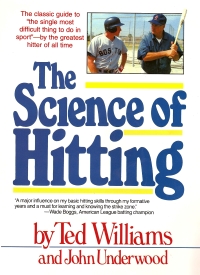 I get lots of question about Rotational Hitting. As a result, I
have put together this FAQ of answers to Frequently Asked
Questions about Rotational Hitting to try to address those
questions. I get lots of question about Rotational Hitting. As a result, I
have put together this FAQ of answers to Frequently Asked
Questions about Rotational Hitting to try to address those
questions.
Why do you spend so much time talking about Rotation?
What other word would you use to describe what Matt Carpenter
does in these clips?
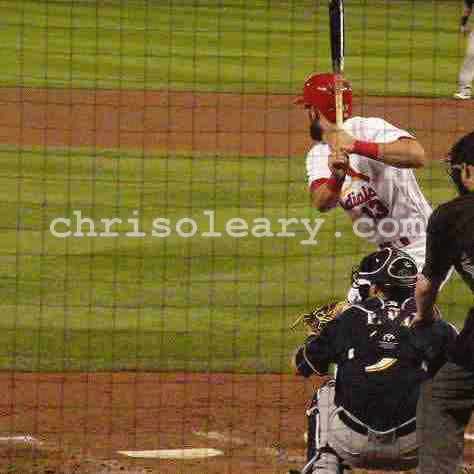
Matt Carpenter Rotating Into Contact
Believe me, if I could think of a better word to use to
describe what Matt Carpenter is doing, I would, given the
baggage associated with the term
Rotational
Hitting.
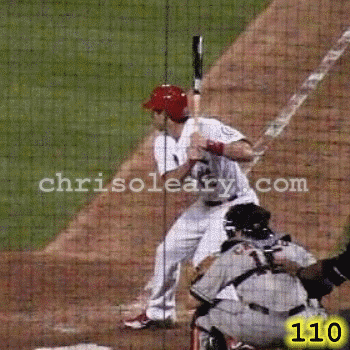
Matt Carpenter Rotating Into Contact
But I can't.
Aren't there both linear and rotational components to
the high-level swing?
Yes.
Of course.
A high-level swing combines a controlled Linear move — a step
or short stride — and Rotation.
The problem, as I have learned working with major league hitters
like...
...is how many people are striking the balance between Linear and
Rotational movements. In my experience, hitting coaches are
teaching...
- TOO MUCH of a linear move, which reduces
the hitter's adjustability.
- TOO LITTLE or even NO
rotation, in large part because they don't understand concepts
like Timing and Adjustability.
I will be the first to admit that there are a number of cues that work
for many hitters by delaying Rotation.
They work well.
As cues.
But they (actually) work by delaying
rotation, not by eliminating it.
Unfortunately, people
at the highest levels of the game continue to talk about rotation as something that shouldn't
happen until after the point of contact, and that's simply not
what the best hitters actually do.
I literally don't know how else to describe what I see in the
clip below other than to say Albert Pujols' swing combines
a Linear step and a small, controlled weight shift and then the
rapid and powerful Rotation of his hips and shulders into the
Point Of Contact.
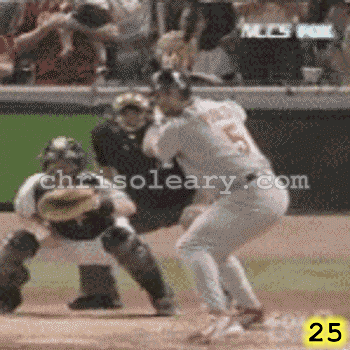
Albert Pujols Rotating Into Contact
Look at Albert Pujols' hips and shoulders at the Point Of
Contact. How they have rotated open. What word describes what
happened better than Rotation?
But why focus on Rotation?
In my work with minor league and major league
hitters, I have found that most higher-level hitters' problems
result from a lack of Rotation. That problem tends to get
worse, not better, the higher you go up the instructional ladder.
For instance, Andres Torres' problem when he came to me wasn't
his ability to make contact. Rather, his problem was his inability
to hit the ball hard enough to get it past major league defenses.
The root cause of his problems came down to a problem with Rotation; he
was trying to power his swing with his hands and not his body.
Similarly, and as I discuss in my piece on
the problem with
hitting instruction I have recently been talking to a minor leaguer.
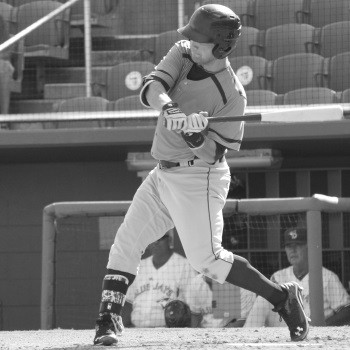
That's a HELL of a Swing
His swing caught my eye due to its uncanny resemblance to the
swing of Mickey Mantle.
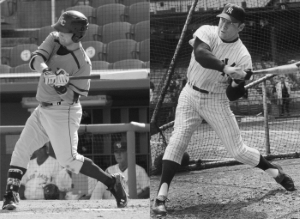
Looking Like Mickey Mantle is a GOOD Thing
However, he hasn't lived up to the
potential that I saw in that picture.
Why?
The problem is that his
coaches are taking his swing in exactly the wrong direction.
Rather than focusing on Rotation, they are taking it out of his
swing and teaching him to swing with just his hands.
Not surprisingly, his ability to hit for power, and then
average, disappeared and he's now out of baseball.
Don't Rotational Hitters have a problem with pulling off the
ball?
The major objection to the concept of Rotation is that it will
lead to pulling off the ball.
That may be true if the only thing you teach is Rotation.
However, while Rotation is the first concept I teach, it is only one of many.
First, there's a reason
why I use the term "Curved Hand Path" and not "Circular Hand
Path." Second, concepts like Timing and
Adjustability enable my hitters to hit for both power and average.
What about the stride? Most hitters, and pretty much
all good ones, use a stride. Do you teach a stride?
One, in my opinion valid, criticism of Mike Epstein's hitters
is that many take a small stride or even a negative stride.
I
follow Ted Williams' advice and example when it comes to the
stride.
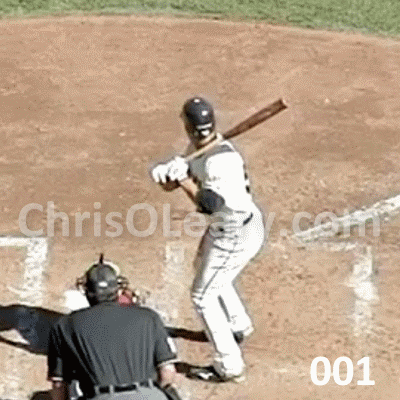
You Don't Have to Move a LOT if you Move WELL
In the clip above, which shows Andres Torres hitting a home run
to right field, he takes a stride. Yes, it's a small one, but it's
enough to give him room to Load and create Separation.
Why should kids copy major leaguers? These men live in the
weight room and spend hours upon hours playing and
practicing. When kids say to me, "so and so doesn't hit like
that..." I respond to them by saying, "well, when your
forearms get as big as your head, you can hit however you
want."
If you look at the swings of good young hitters, regardless of
how old they are and whether they are male or female, you will
see that they do the same basic thing as major leaguers.
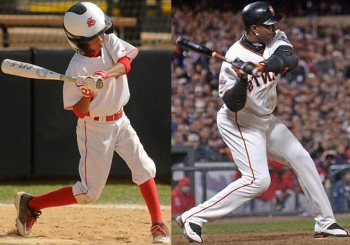
The High-Level Swing
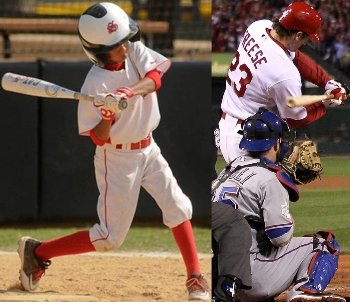
The High-Level Swing
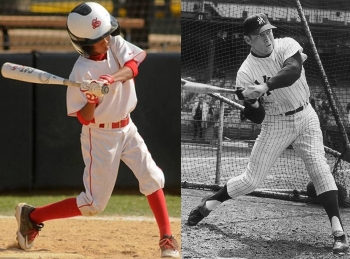
The High-Level Swing
That is because the physics are the same; a swing is either
efficient or it isn't and a rotational swing is the most efficient
swing.
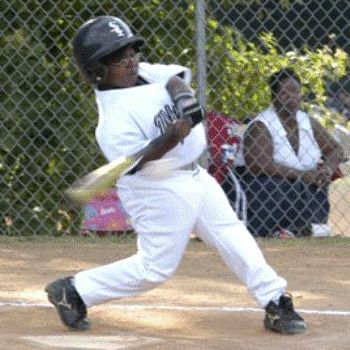
The High-Level Swing
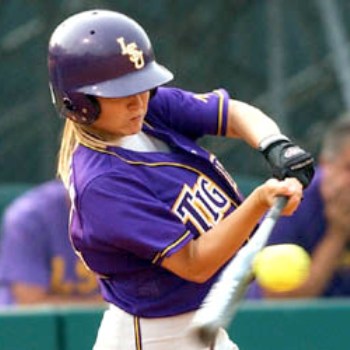
The High-Level Swing
Of course, kids and females don't have the same levels of strength
as adult male baseball players, but that's why they swing
lighter bats and player in smaller ballparks. That evens things out and lets kids and females use the same mechanics
as major leaguers.
Isn't Rotational Hitting only appropriate for power hitters?
No. Studies show that one key to hitting for average is hitting
the ball hard. That is because the harder you hit the ball,
the faster it gets through the infield or
outfield and the harder it is for the fielders to make a play on
the ball. When I work with hitters, I don't explicitly teach them
to try to hit home runs. Instead, I teach them to just hit the ball solidly and
well. Home runs will happen if they do everything perfectly.
What major league hitters use Rotational Hitting?
Virtually every major league hitter's swing is consistent with
the principles of Rotational Hitting. The only significant
exception is Ichiro Suzuki, and that is only when he is trying to
slap an outside pitch. Pitch Ichiro Suzuki inside and he will use
a textbook rotational swing.
At what age can you start teaching kids about the
high-level swing?
While most kids aren't going to be able to work on the
higher-level concepts before 5th grade or so, it's never too early
to start teaching kids how to rotate well and to swing with their
entire bodies and not just their arms.
Aren't the linear and extension approaches to hitting
equally valid alternatives for some players?
No.
While they may work at the lowest levels of baseball and
softball, they do not scale. In fact, in many cases they stop
working beyond 4th grade. That is why you don't see see linear hand paths and
extension at the Point Of Contact (POC) in good major league
swings. Generally, the only time you do see linear hand paths and extension
at the POC is when a hitter is fooled or is making an adjustment.
I think that Dave Hudgens does a pretty good job
explaining the differences between Rotational Hitting and Linear
Hitting. What do you think of his work?
I think that Dave Hudgens buys into some fairly common, but
incorrect, misconceptions about what Rotational Hitting is and
what a good swing actually looks like. I discuss this in my piece
Analyzing Dave Hudgens' Views on Hitting.
Regarding the Lau quote on your piece about Rotational
Hitting...
At the moment of contact, the bat should be straight out in front of
you, your arms should be fully extended...
...doesn't that Lau quote have validity?
The reason why I don't think I'm misinterpreting that
quote — as I have been accused of in the past — is that it corresponds with all of the posed pictures of
George Brett that you will find in Charley Lau Sr.'s book The
Art of Hitting .300. The position that you see in the
picture below...
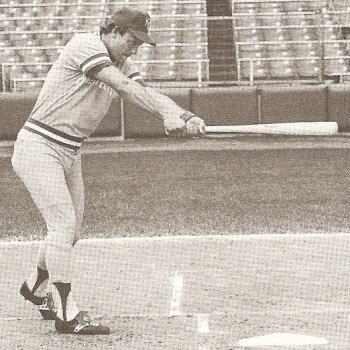
George Brett Demonstrating
Extension at the Point Of Contact
...is also what I was taught, and what many people are
being taught, as the desired position at the Point Of Contact of
every swing (and not just pitches
outside).
The problem is that what Charley Lau Sr. advocates isn't what
you see in the swings of the best hitters. The picture above of
George Brett, where he is demonstrating what a hitter should look
like at the Point Of Contact, looks nothing like the picture below
of Albert Pujols at the Point Of Contact.
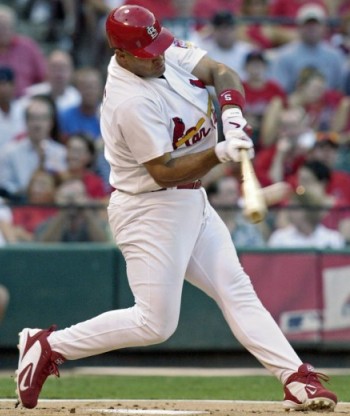
Albert Pujols
As I understand Lau, for maximum bat acceleration
start with a small turn radius, the bat at 45º or less (see
George Brett and Andres Torres) to the arms "fully extended" for
maximum velocity at contact (see Ted Williams). In golf it's
called "restoring the radius."
If Lau said that, then he was wrong.
Extending at the Point Of Contact isn't going to reduce
the radius and speed up the swing. Rather, it's going to increase
the radius and slow down the swing.
That is the point of the
spinning ice skater analogy that is so often used; when the arms
come in, the ice skater rotates faster and, when the arms go out,
the ice skater rotates slower.
That's also why,
rather than seeing Extension at the Point Of Contact, you
generally see Connection at the Point Of Contact and don't see
Extension until the hitter is well into their follow-through.
This picture of Jason Giambi...
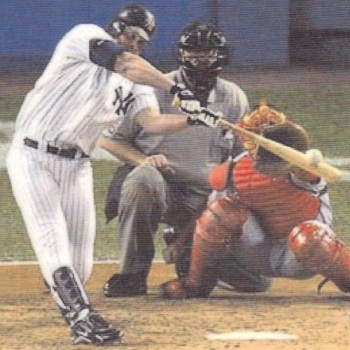
Jason Giambi
...is what Lau had in
mind. But my question was of the two pictures, the one you
posted of Pujols with his arms pulled in, or Giambi, with his arms
extended which one would produce the most bat speed, all other
things being equal. Or, another way of putting it, would Pujols
have more bat speed (power) if he looked like Giambi. Also, it is
bad for a coach to teach full extension at contact, but it would
be equally as bad or worse for a coach to teach arms pulled in.
The hands follow the head and the arms will extend accordingly.
The problem with trying to do what Giambi is doing on
every
swing is that you are going to reduce your adjustability and won't
be able to hit balls over the inner half of the plate and still keep
them fair. Instead, you would pull hook everything inside. You
also won't be able to adjust to and hit quality off-speed
pitching.
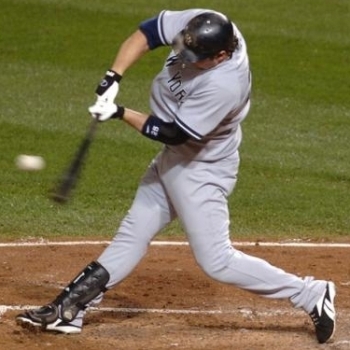
Jason Giambi
That is why Jason Giambi doesn't extend on every pitch. Instead, he extends his arms or pulls them in depending on the
location of the pitch; he extends more on pitches outside
and stays tightly connected on pitches inside.
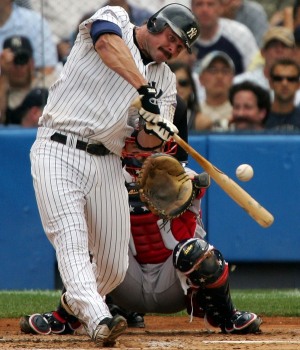
Jason Giambi
In general, hitters tend to hit the ball harder when
their arms are closer in to their body because that allows
them to rotate faster. Thus the phrase, "Baseball history is
made over the inner half of the plate."
You wrote on your web site, "That's why,
rather than seeing Extension at the Point Of Contact, you
generally see Connection at the Point Of Contact and don't see
Extension until the hitter is well into their follow-through."
Charlie Lau would agree. He writes on page 29 that even with the
best batter it full extension will only
happen 1 of 100 swings. This is because the degree of extension at
the point of contact varies and is a function of pitch location
and the intent of the batter. For example on a outside pitch
a batter has to extend to hit the ball. On an inside pitch
the batter could chose to let the ball get in on him and not
extend at contact (like many of the pictures of Pujols you show),
or he could, like Ted Williams, hit the ball way in front and
extend. By the way, Williams calls the type of swings you
usually show as swinging "inside out" which, according to him, is
used only in special circumstance.
First, many people believe — or at least say and/or would want
you to believe — that proponents of Rotational Hitting believe
and teach that hitters should be connected on
every swing and never extend at
the Point Of Contact.
That's not accurate (at least as far as I am concerned).
The fact is that extension at the Point Of Contact is part of
how hitters adjust to hit pitches over the outer part of the
strike zone.
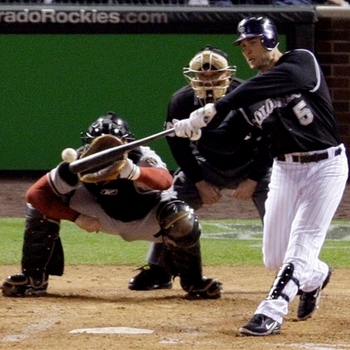
Matt Holliday's Extension
The problem with how Lau's work is interpreted is that many
people teach that hitters should reach full extension on
every swing, regardless of whether the
pitch is inside or outside.
That is called making the Power V at the Point Of Contact.
Second, I am very familiar with the work of both Lau's, having
read Charley Sr.'s book and viewed his videotapes and having spent
the weekend talking hitting with Charley Jr. I can't find any such
statement about extension on page 29 of any of their books that I
have. I assume that is why the work of the Lau's is
(mis)interpreted as it is.
I had some questions about extension.
First, my understanding of why people emphasis full
extension is so that when the ball makes contact it is at its
maximum velocity.
Unfortunately, the physics on this are wrong.
Extending at contact will slow the bat down, not speed it
up.
You don't want hitters decelerating the bat
at impact, even a little.
That's true, but extending won't guarantee this.
Doesn't extension keep the barrel of the bat in the
hitting zone a tad longer.
Yes, but if you try to extend on every swing, then you lose
the ability to make this adjustment. For it to work, you
have to reserve it for when you are fooled by a good
off-speed pitch.
Isn't the point of extension like when you coach your players to run
hard through the 1st base (extend) and not
to slow down until you are by the bag. Its
just faster!
The problem is that this analogy doesn't work because the
physics are totally different.
Running through the
base means extending your maximum velocity through the base.
However, when running you can maintain peak velocity for an
extended period of time.
The same isn't true of the
swing because it relies on a mechanical trick (the whip
effect due to the curved hand path) rather than pure
muscular activity.
Doesn't Rotational Hitting encourage big uppercuts?
No.
Rotational Hitting does encourage an uppercut, but only a
slight uppercut.
The goal is for the plane of the swing to match the
plane of the pitch. Since every pitches crosses the plate on a
slight downward angle, the way to hit pitches squarely is to swing
with a slight uppercut. In general, that means swinging with a
slight (10 degree) uppercut and not a dramatic (45 degree)
uppercut. The only time a rotational hitter will swing with a
significant uppercut is when they are trying to hit a
rapidly-dropping, 12-6 curveball.
I am a coach of a 16u select travel baseball team. I
have a hitting instructor in our area teaching some of the players
to swing down on the ball or to swing like you are chopping wood.
Is this correct?
No.
That's going to minimize the time that the planes of
the barrel and the ball cross and reduce the chance that they will
make contact.
Like Ted Williams said, good hitters swing
with a slight uppercut, because that lets them match the plane of
the swing to the plane of the pitch.
Won't an uppercut lead to dropping the back shoulder and
pop-ups?
Every good hitter drops their back shoulder at least a
bit because that is how you swing with a slight uppercut and
match the plane of the swing to the plane of the pitch. Dropping
the back shoulder is also tied into the way that good hitters
adjust to hit balls down in the strike zone.
When the upper body commits to the pitch, the front
side moves where? Out. Find me one player that has been
successful that believes it is OK for your
front shoulder to come out, and I won't believe they
were successful.
I don't know whether any good hitters believe that it's OK for the
front shoulder to come out or not, but video
shows that the front shoulder always comes out and around.

Albert Pujols' Front Shoulder
Rotational Hitting offers no time to adjust to a
pitch that is not middle to middle in. Because the chest of
the hitter is not over the plate, they can't cover the
outside part of the plate. This is the biggest advantage of
linear hitting. People who stay over the plate can cover
the plate.
One of the keys of Rotational Hitting is that,
and as Ted Williams said, the hips lead the hands (and thus the
shoulders). That means that, while the hitter's hips may
be open, their shoulders will stay closed through the
start of the swing.

Jeff Clement's Rotation
That keeps the front shoulder from
flying open too early and lets the hitter hit the outside pitch.
It also boosts the power output of their swing.
If the hips open then the hands will follow. On an outside pitch, the hips must remain
closed in order to hit it to the opposite side of the field.
Your statement, and belief, doesn't match up with reality.
The clip below shows Jose Bautista hitting a home run to
right field. If you watch his belt buckle, you will see that
his hips rotate 90 to 100 degrees.
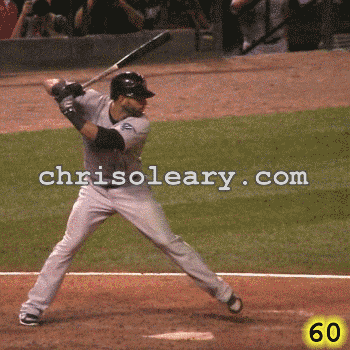
Jose Bautista's Hip Rotation
The fact is that the hips and the shoulders are quite capable of moving
independently; just because the hips rotate, it doesn't mean
that the hands can't make the necessary adjustment outside.

Matt Holliday's Hip Rotation
Here is a picture of Matt Holliday hitting a home run to the opposite field. Notice how his hips are completely open, and his belt buckle is rotated
beyond the pitcher. However, he was still able to hit this pitch because he held
his hands and his shoulders back while his hips opened.
One problem with hitting rotationally, is once you
commit, all your weight has already been transferred and
you are left with just upper body strength to hit a
change up or curve ball. When your weight transfer goes
back to the catcher and forward to the pitcher...you can
adjust to multiple pitches.
While some people equate Rotational Hitting with a
no-stride swing, the fact is that properly-coached Rotational
Hitters are taught how and when to transfer their weight in
order to adjust to the speed of the pitch.
The hips can only rotate as
a result of a weight transfer.
The hips can very easily rotate without a weight transfer.
That's how you make a hula hoop work, for example.
Also, while people like Mike Epstein do not teach a stride
when they teach Rotational Hitting, that doesn't mean that that is
the right way to teach Rotational Hitting.
When I teach Rotational Hitting I teach at least a
weight shift, if not a stride. In fact, one reason I put together my
Rotational Hitting 101 DVD was to address what I believe are
the weaknesses of how Mike Epstein teaches Rotational Hitting and
to explain how I think Rotational Hitting should be taught.
If you transfer weight, and rotate your hips, then
all you have left is your upper body to hit with when a change
up comes. You can't have both.
That is true, which is why it's important that hitters know
how to delay the planting of their front heel. It's also one
reason
why
Albert Pujols struggled during the first few months of 2011.
To increase bat speed
rotation of the torso has to slow down so that energy can be
transferred to the arms and bat. Much like a car in a collision,
the sudden decrease of velocity is what propels the passenger
forward. During the swing power is initiated with the lateral
weight shift of the batter with the front leg acting as a brake. The swing and any torso rotation is a result of the weight shift
braced by the front leg. Look at a picture of a swing taken at
normal speed. The hips are always clear but the bat is a blur.
First, if the only way to rotate the torso is by slamming it
into a rigid front leg, then how are minimal to no stride hitters
successful?
The truth is that a stride and weight shift can help boost the power of
rotation (but at a cost). The hips are perfectly capable of rotating on their
own, which is why we can walk, among other things.
Second, the reason whip the hips are clear but the bat is
blurred is because the bat is moving much faster than the hips,
not because the hips aren't moving. If you compare the position of
a hitter's hips at the start of their swing and at the point of
contact, you will always see significant rotation.

Jose Bautista's Hip Rotation
It's important to
hit the ball hard...yes. But it's also important to hit the
ball where it is pitched. That means you have to cover the
plate. If what you teach cover's hitting the ball hard to the
opposite field...than I am fine with it (but I would argue
you can't do that if your front side comes out). The girls I
teach...can't.
Good hitters know how to delay the rotation of the hips and
shoulder in order to be able to cover the whole plate. They
also know the right way to use their arms to cover the entire
plate.
I read in your article that rotational
hitting involves using the entire body and linear
hitting doesn't incorporate large muscles. I disagree
with that thought. Females have to use our legs to have
any power. It is when the transfer of weight, and proper
hands come together...with the proper TIMING...in
addition to the power provided by the pitcher...that a
ball is hit hard.
By the entire body, I mean the hips and the core rather
than just the arms (and I explicitly say so in my
Rotational Hitting 101 DVD).
The whole reason I teach Rotational Hitting to females is
because it lets them tap into the muscles of the core, and
everyone who can walk has relatively strong core muscles.
The problem with linear hitting, at least how it's taught
around here, is that it's taught as an extremely arm-y
approach where the use of the core is minimized.
If what you teach
involves being able to adjust to different speeds...then I am
fine with it. But the girls that come see me...who have been
taught to commit with their hands and hips...have nothing left
when they see a change up.
Then they are not being taught correctly.
Part of the problem is that a lot of what is being
sold as Rotational Hitting bears little to no
resemblance to the
High-Level
Swing and what the best hitters actually do.
Baseball is very similar to other sports. Golf. Boxing.
Both (at the pro level) involve rotation...but a boxer steps
toward his target before his hips unleash. A golfer may bring
his club behind his head...but around the point of contact is
linear. It's the same...it all carries over. Can you imagine
if a pitcher was being taught to pitch in a way where his front
foot or glove comes off the mound to the side...to make sure
his back hip comes through? We want to hit in a way where we
have control, strength, balance, and power.
Like baseball, boxers use a linear stride to boost the
force of their rotation; linear translation gets turned into
rotation.
I don't think there's any linear component to golf; it's as
purely rotational as you can get, and more so than baseball.
My cousin is a pro at Pinehurst and talks
about the linear component of golf. It is also discussed on
this site. Check it out. I think the same is true with the POC
in baseball. The correct path of
the golf swing is a linear path which means the club head
travels along the target line for a length of time.
The head of a golf club never moves linearly; it's always
rotating around the hands.
Doesn't rotation happen as a result of an aggressive
swing? I don't believe that it needs to be taught. It happens
naturally. In fact, I believe our tenancy is to OVER rotate.
No.
It's quite possible to move linearly and still never rotate.
That is because it's possible to move, and rotate, the legs
without rotating the hips.
What's more, in my experience with kids, I see far more problems with
too little rotation — and
top-down, arm-y swings — than problems with too
much rotation.
In general, I think a big part of the problem is that people
haven't looked closely enough at good video.
Just because Ted Williams said the hips lead the hands,
doesn't mean that is true. Tony Gwynn says the hands lead. That
keeps their front shoulder from flying open too early and
helps to boost the power output of their swing.
Video evidence clearly demonstrates that Ted Williams was
right. In every good swing, the hips lead the hands (and the
shoulders).
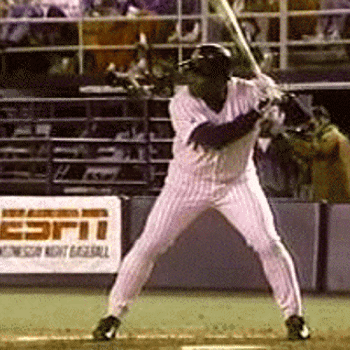
Tony Gwynn's Swing
If you look at the swing above of Tony Gwynn, you will see
his hips rotate ahead of his hands (and his shoulders).
In general, Tony Gwynn doesn't have a good understanding
of what his of swing looked like, I assume because of the
blurring in the video equipment that he used. For instance,
Tony Gwynn rails against a flaw called a loop in the swing
where the barrel drops below the hands, but Gwynn very
clearly had a loop in his swing.
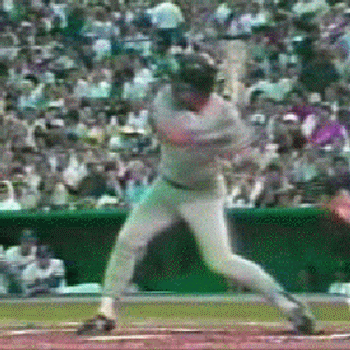
Don Mattingly's Swing
The same is true of Don Mattingly. He teaches that
hitters should keep the barrel above their hands, but he
very clearly didn't do that in his own swing. Instead, the
barrel drops well below his hands.
Does the New BBCOR Bat Standard Make Rotational Hitting
More Important?
Absolutely.
The BBCOR (Batted Ball Coefficient Of Restitution)
standard will reduce, and even out, the performance of bats,
perhaps by as much as 20%. As a result, hitters will no longer be
able to get a power boost just by buying the latest "hot" bat.
Instead, the quality of one's swing will become more important,
and understanding Rotational Hitting is the key to developing a
good swing.
Do You Have Any Presentations or Other Materials That Will
Help me Sell Rotational Hitting to my Players,
players'
Parents, and Organization?
Everyone who buys my
Rotational
Hitting 101 DVD will get access to my client-only web site. That
gives you access to client-only materials, including presentations
and other tools that will help you sell Rotational Hitting to your
players, players' parents, and/or organization.
Rotational Hitting 101 DVD
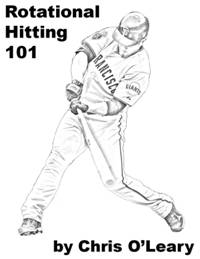 In
2008, I took much of the information that had been blogging about,
organized it, added to it, and put together
Rotational Hitting 101 and
my
client site. They reflect the lessons that have been learned
about the high-level swing over the past ten years. They build on
the strengths, but also address what in my experience are the
weaknesses, of Mike Epstein's approach to teaching hitting. In
2008, I took much of the information that had been blogging about,
organized it, added to it, and put together
Rotational Hitting 101 and
my
client site. They reflect the lessons that have been learned
about the high-level swing over the past ten years. They build on
the strengths, but also address what in my experience are the
weaknesses, of Mike Epstein's approach to teaching hitting.
Since I first published Rotational Hitting 101, I have
shipped more than 2,000 copies of my DVD to people all over the
world including
Andres
Torres, my first professional client.
Andres used the information on my DVD, and in particular my
information on
Connection, to
rebuild his swing and his entire approach to hitting. The result
was a swing that helped the San Francisco Giants win the 2010
World Series.
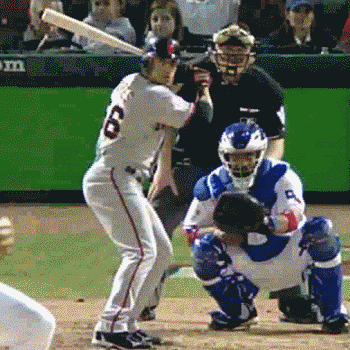
Andres Torres
Home Run to Right Field
2010 World Series
Major League Experience
Andres Torres
isn't the only major league baseball player I have worked
with.
At last count, I have three other clients in the major leagues,
two clients at AAA, one client at AA, and
two clients playing for independent minor league teams and
trying to get back on the road to the major leagues. I have also
worked with a number of D-1 college baseball and fast pitch
softball players.
I don't give out the names of these players because I don't
want to get them in trouble with their coaches. While they, and I,
believe in what I teach, most of the time it contradicts what
their coaches are saying, so they have to keep it to themselves
and we have to work on the down low. If you are a minor leaguer
and are looking for help,
e-mail me and we can talk about how you can get access to my
client-only web site.
|